Abstract
As the population grows, there is a need to address the continuous depletion of non-renewable energy sources and their negative effects on the environment. This led to a substantial assessment of possible innovations and raw materials to increase the volumetric productivity of alternative fuels to supply the energy needed worldwide. In addition to its environment-friendly properties, a biofuel derived from plant-based sources is also a sustainable material. For high ethanol production from plant-based biofuel, several techniques have been developed, including cell or enzyme immobilization. The key purposes of utilizing immobilized cells or enzymes are to improve bioreactor yield with upgraded enzyme establishment and to increase enzyme utilization. The fermentation of sweet sorghum extract to produce ethanol was conducted in this study, and it was found that the optimum sodium alginate concentration for immobilizing yeast is 3% w/v. It was also found that the free yeast has a shorter optimum fermentation period which is four days (96 h), in comparison with the immobilized yeast, which is five days (120 h). The immobilized yeast has a higher ethanol concentration produced and percent conversion compared to the free yeast. The immobilized yeast entrapped in calcium alginate beads permitted ten five-day (120 h) reuse cycles which are still in stable final ethanol concentration and percent conversion. Due to a lack of experimental support in the necessary condition (optimum level of the number of fermentation days and the concentration of sodium alginate) for the optimal ethanol yield from the extract of sweet sorghum, this study was conducted. This study also tried to address the global demand for ethanol by specifying the optimum conditions necessary for efficient fermentation, specifically for ethanol production using an extract from sweet sorghum. Furthermore, this experimental work serves as a basis for further investigations concerning ethanol production from Agri-based materials, such as sweet sorghum.
1. Introduction
Inevitably, energy security is essential for attaining and maintaining sustainable development for both developed and developing countries. Today, we are still relying on conventional and non-sustainable energy sources, such as oil, coal, and natural gas, to supply most of the energy demand [1,2]. The utilization of crude oil as the major source of energy has impacted the generation of global dilemmas, such as global warming and air pollution [3,4].
As the population grows, there is a need to address the continuous depletion of these non-renewable sources of energy and their negative effects on the environment. Several innovations to achieve sustainable resources that are environmentally friendly have been carried out, like the production of charcoal briquettes from peanut shells [5], a water filtration system [6], and the recovery of materials from wastewater [7]. A substantial assessment of innovations and compounds to increase the volumetric productivity of alternative fuels to supply energy is needed worldwide. The production of biofuel can be freely generated from plant-based renewable materials, and this has the benefit of being environment-friendly [8].
Ethanol is a versatile substance with various applications in commercial enterprises and everyday life. It is utilized as a raw material in liquor production, a popular solvent in many industries, and an environmentally friendly fuel. Ethanol has emerged as a viable source of alternative fuel, produced through the fermentation of natural sugars, such as sugarcane, sorghum, and others [9]. According to a report, the global production of ethanol peaked in 2015, with 85% of the ethanol produced worldwide originating from the United States and Brazil. Currently, several countries now mandate blending at least 5% ethanol into their gasoline [10]. The significant increase in ethanol production raises concerns about the limited availability of raw materials, most of which are also food sources for humans, such as corn, sugarcane, molasses, and cassava. Other alternative substrates for ethanol production have been identified and extensively studied.
Among the alternative substrates is sweet sorghum. Sweet sorghum is the fifth most important cereal crop and one of the most interesting raw materials for ethanol production. Using sweet sorghum as feedstock for fermentation has many advantages. One is the availability of the said raw material in the locality, and another is its high sugar content, ranging from 15% to over 20%. Sweet sorghum has been noted for its potential as an energy crop. The juice is better suited for ethanol production due to its higher reduced sugar content as compared to other sources, such as sugarcane juice [11]. Moreover, sweet sorghum grows readily in saline or alkaline soils. It has a great tolerance for a wide range of climatic and soil conditions. It can withstand stress and is inexpensive to cultivate. It is a short-duration crop of 110 days to 130 days (about 4.5 months), as compared to 12 months to 18 months (about 1.5 year) in the sugarcane. Its water and fertilizer requirements are much lower than those of sugarcane. Thus, this results in a lower cost of cultivation [12,13].
Conventional alcoholic fermentation, particularly on first-generation bioethanol feedstock, utilized plants as raw materials like wheat, corn, potatoes, beets, sugarcane, and sweet sorghum [14]. These materials are excellent components for the easily accessible starch and sugar required for fermentation [15]. Production efficiency is another vital factor affecting the yield of ethanol. Traditional ethanol fermentation has a long production cycle and low utilization of starch. For high ethanol production, several techniques have been developed, including continuous culture, cell or enzyme immobilization, cell culture, cell recycling through sedimentation or membrane retention, and a two-stage reactor system [16].
In ethanol production, the most studied and used eukaryotes with multiple identified species are Saccharomyces cerevisiae. It is also the most utilized variety in the industrial-scale production of ethanol because of several advantages, including its fast-growing specie, competent anaerobic metabolism of sugar, high ethanol yield, great productivity, and elevated tolerance to several environmental pressure like elevated ethanol content, low pH, and low oxygen level [17,18].
One of the procedures used for physical and chemical fixation to upgrade the stability of cells, organelles, enzymes, and proteins on solid supports is immobilization. This technique allows the utilization of these materials repeatedly. Several applications of immobilization in the manufacturing industries can be identified. One such industry is involved in drug production, biotechnology, food and beverages, and biosensors, with a specific focus on the dairy sector. The immobilization method offers numerous advantages over free cells [19,20], including recyclability [21,22]. Moreover, the immobilization process can lead to stable production of ethanol in repeated batch fermentation, thereby offering a cost-effective option for achieving high ethanol productivity [23].
The preeminent purpose of immobilizing enzymes, cells, organelles, and proteins is to improve the bioreactor yield with improved cell stability and for smarter utilization of the substrate. One more purpose of this technique is the potential to decrease the start-up period by cultivating the necessary substrate at a higher concentration of nutrients in the culture media. This identified advantage is only possible if immobilized yeasts display a significantly longer lifespan than free yeasts. The application of immobilized yeasts can be utilized both for batch and continuous reactor operations. Immobilization can be classified in accordance with the physical mechanism of immobilization. Methods of immobilization of microbial cells can be classified as physical entrapment within the porous cast, encapsulation, adsorption, attaching the cells to a pre-formed bearer, and cross-linking. The procedure should be conducted in a mild environment to preserve the activity of the microbial cells [24].
This study was conducted to address the lack of experimental data on the optimum conditions required for optimal ethanol production from sweet sorghum. Specifically, the necessary conditions and achievement of the optimum level of fermentation days and sodium alginate concentration have not been adequately supported by prior research, hence the need for this study.
Thus, the aim of this study is to address the increasing global demand for ethanol by determining the precise optimal conditions required for efficient fermentation to produce ethanol from sweet sorghum. This experimental work also intends to serve as a foundation for further investigations into ethanol production from sweet sorghum.
The primary goal of this study was to optimize the production of ethanol from sweet sorghum juice through the immobilization of yeast by entrapping it in calcium alginate beads. To achieve this, the study aimed to determine the optimal fermentation conditions in terms of the concentration (%w/v) of sodium alginate and the fermentation period required to yield the maximum amount of ethanol. Additionally, the study aimed to compare the percent yield of ethanol produced between immobilized yeast and free yeast, investigate the reusability of calcium alginate beads using the optimal sodium alginate concentration and fermentation period, and provide and compare SEM images of calcium alginate beads with and without yeast. These findings will provide a better understanding of the optimal conditions required for the efficient fermentation of sweet sorghum juice to produce ethanol and will contribute to the development of sustainable and environmentally friendly sources of ethanol. Furthermore, the results of this study may serve as a basis for future research on ethanol production from sweet sorghum and other alternative substrates.
2. Materials and Methods
2.1. Chemicals and Reagents
Sweet sorghum (Sorghum bicolor, L. Moench) stalks of variety SPV 422 were collected from the local plantation located at Mariano Marcos State University and at Brgy. 25 Tubburan, Bacarra, Ilocos Norte, Philippines. The sweet sorghum stalks were milled to extract the juice. The extracted juice was concentrated to 22° Brix through a water bath. The sodium alginate was purchased from Sigma-Aldrich (St. Louis, MO, USA), and dried Baker’s yeast was obtained from a local dairy store in the City of Batac, Ilocos Norte, Philippines.
2.2. Experimental Methodology
The sodium alginate was sterilized in an autoclave at 120 °C for 15 min. Dried Baker’s yeast (S. cerevisiae) of 0.9425 g weight was dissolved in 4.7125 mL distilled water and mixed in a small mortar and pestle until a smooth paste was formed. This ratio was constant for all the treatments. The preparation of 0.15 M of CaCl2 was done by dissolving 22.0473 g of CaCl2 powder in 1 L of distilled water.
A 2 percent w/v sodium alginate solution was prepared by dissolving 4.7125 g of sodium alginate powder in 235.625 mL of distilled water. The preparation of the yeast-alginate mixture was carried out by preparing the yeast paste and dissolving it into the sodium alginate solution, followed by stirring the mixture thoroughly to ensure homogeneity [25,26].
The next step is the formation of calcium alginate beads. The yeast-alginate mixture was transferred in a dropping device, specifically a 10 mL syringe. The beaker containing 1 L of 0.15 g calcium chloride was placed below the dropping device, which was magnetically stirred to produce a light vortex. The dropwise flow was controlled to allow the flow to fall from a height of about 10 cm into the calcium chloride solution. The mixture was stirred for 20 min to 30 min before the beads were collected using a large strainer. The beads were washed with 1 L of distilled water [27].
Fermentation of sweet sorghum juice using calcium alginate beads at different concentrations was conducted to determine the optimum concentration. Fermentation using free yeast was also conducted for the purpose of comparison. Two hundred fifty mL of 22° Brix sweet sorghum juice extract was utilized for the fermentation. All the prepared calcium alginate beads were put into an Erlenmeyer flask for fermentation. A fermentation lock fitted in the Erlenmeyer flask was then placed. The solution was fermented for 5 d, and the volume of ethanol produced was then determined. SEM was used to get micrograph images of the outside surfaces and cross-sectional surfaces of calcium alginate beads without yeast, calcium alginate beads with yeast (fresh), single-used calcium alginate beads, and multiple-used calcium alginate beads. The reusability of the calcium alginate beads was investigated by employing the optimum sodium alginate concentration and optimum fermentation period. The beads were used in repeated batch fermentation to analyze the reusability as an advantage of immobilized yeast.
3. Results
Immobilized Saccharomyces cerevisiae were prepared and entrapped in 2–3 mm average diameter calcium alginate beads.
3.1. Determination of the Optimum Fermentation Conditions
3.1.1. Optimum Concentration (% w/v) of the Sodium Alginate in Terms of Yield of Ethanol
The study attempted to investigate the effect of immobilization of Saccharomyces cerevisiae in fermentation through the entrapment method, utilizing calcium alginate beads as the insoluble matrix. Sorghum bicolor L. Moench of SPV 422 variety was the source of fermentable sugar converted to ethanol. The results of fermentation using immobilized yeast as a function of sodium alginate concentration from 2% to 4% w/v of solution are summarized in Table 1.

Table 1.
Ethanol Concentration and Percent Conversion of Sweet sorghum to ethanol in terms of varying sodium alginate concentrations.
As shown in Table 1, the optimum sodium alginate concentration is 3%, with an ethanol concentration of 12.20% v/v and 85.15% conversion. A minimal difference can be observed compared to the values of the 2% and 4% sodium alginate concentrations which also obtained at 83.33% and 83.03%, respectively.
3.1.2. Determination of the Optimum Fermentation Period
To determine the optimal fermentation period, the study utilized the previously optimized sodium alginate concentration of 3%. The results of the fermentation using immobilized yeast as a function of the fermentation period are presented in Table 2. The data from the study indicate an inverse relationship between the sugar content of the fermenting medium and the ethanol concentration over time. This means that as the fermentation period progresses and ethanol concentration increases, the sugar content of the fermenting medium decreases. This inverse relationship is important to consider in the optimization of the fermentation process, as it suggests that there may be an optimal point at which the ethanol concentration is maximized while minimizing the depletion of the sugar content of the fermenting medium. This finding can aid in the development of more efficient and sustainable methods for ethanol production from sweet sorghum.

Table 2.
Different ethanol concentrations and percent conversions in different fermentation periods.
The experimental data revealed that the fermentation period of five days (120 h) yielded the highest amount of ethanol production, with a percent conversion of 85.15%. It is noteworthy that a continuous increase in ethanol yield and percent conversion was observed during the first five days of fermentation. However, a sudden decrease in the yield of ethanol was noticed on the sixth day of fermentation.
3.2. Comparison of Ethanol Yield and Percent Conversion between Free Yeast and Immobilized Yeast
To compare the ethanol productivity between free yeast and immobilized yeast, the study presents Table 3, which summarizes the corresponding percent conversion of sorghum fermentable sugar to ethanol, while Figure 1 shows the corresponding ethanol concentrations.

Table 3.
Comparison between free yeast and immobilized yeast in terms of percent conversion.
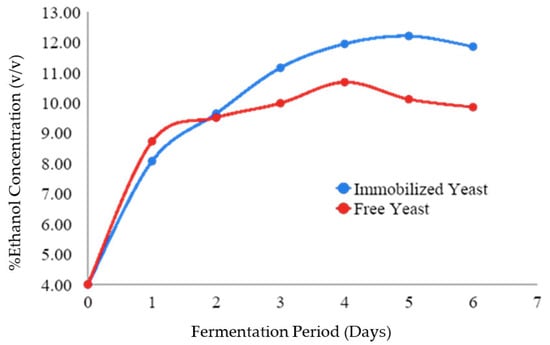
Figure 1.
Comparison between free yeast and immobilized yeast in terms of ethanol yield.
3.2.1. Comparison between Free Yeast and Immobilized Yeast in Terms of Percent Conversion
The fermentation using free yeast and immobilized yeast in calcium alginate beads is shown in Table 3. The highest ethanol yield was obtained on the 4th day for the fermentation utilizing free yeast, while the 5th day was observed for the immobilized yeast, with the percent conversion of the free yeast and immobilized yeast being 74.55% and 85.15%, respectively.
On day 1 (24 h) of fermentation, free yeast showed higher ethanol productivity than that of the immobilized yeast, as shown in Table 3. For free yeast, a percent conversion of 60.91% was observed, compared to 56.36% for immobilized yeast. On the second and succeeding days of fermentation, immobilized yeast shows a higher percent conversion in comparison with the free yeast.
3.2.2. Comparison between Free Yeast and Immobilized Yeast in Terms of Ethanol Yield
On day 1 (24 h) of fermentation, free yeast showed higher ethanol productivity than the immobilized yeast, as shown in Figure 1. This is true since the free yeast directly utilized and converted the glucose to ethanol compared to the immobilized yeast, which first underwent several stages before the conversion of glucose to alcohol occurred. The glucose undergoes mass transfer from the bulk to the bead’s surface and then diffuses through the pores. After diffusion, adsorption of the glucose in the yeast takes place, followed by conversion of glucose to alcohol, followed by desorption of the alcohol through the beads. As the fermentation period proceeds on the second up to the sixth day, higher ethanol productivity was observed for the immobilized yeast, as shown in Figure 1.
3.3. Investigation on the Reusability of Calcium Alginate Beads Using the Optimum Sodium Alginate Concentration and Optimum Fermentation Period
Investigation on the reusability of beads was also conducted by employing the optimum sodium alginate concentration and fermentation period. Table 4 summarizes the ethanol productivity in every batch fermentation utilizing the optimum sodium alginate concentration and optimum fermentation period for immobilized yeast.

Table 4.
Reusability of calcium alginate beads for fermentation.
Table 4 shows that the immobilized yeast was utilized ten times for a five-day (120 h) fermentation and still gave a stable final ethanol concentration. The percentage conversions are still higher compared to the optimum ethanol concentration and percent conversion produced in free yeast, which are 10.68% v/v and 74.55%, respectively. Though it might not be the maximum amount of reusability for the calcium alginate beads, results show that the beads have promising operational stability.
On the other hand, there was a slight degradation of the beads in terms of firmness, and an increase in the inoculum size of the beads as compared to the freshly made beads was observed. The reason for the size increase in the beads is due to the growth and multiplication of the yeast inside it, which led to a higher cell density. There are no signs of rupture on the beads, although their size has increased, which is a good indicator that the beads are still appropriate for reuse.
Furthermore, a decrease in the percent conversions of sugar to ethanol by the reused calcium alginate beads was observed. From the highest conversion on its first and second reuse, which had a corresponding percent conversion of 85.45%, it gradually decreased as the number of reuse cycles increased. This was attributed to the minimal loss of cell activity during every reuse cycle. Thus, the results proved that the use of calcium alginate beads enhanced operational stability by reducing the loss of cell activity.
3.4. SEM Images of Calcium Alginate Beads Utilized for Immobilization of Yeast for the Fermentation Process
The SEM images of the different surfaces of calcium alginate beads were obtained and presented in Figure 2 and Figure 3, magnified at 55 and 1000 times, respectively. In addition, cross-sectional images of the calcium alginate beads were captured and shown in Figure 4 and Figure 5, magnified at 55 and 300 times, respectively.
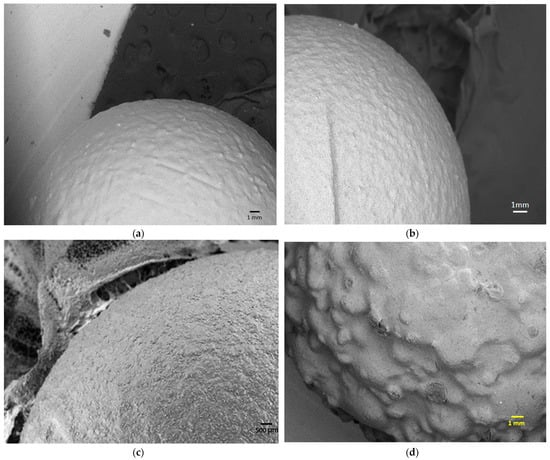
Figure 2.
SEM images on the surfaces at ×55 magnification of (a) Ca-alginate beads without yeast; (b) Ca-alginate beads with yeast (fresh); (c) single-used Ca-alginate beads; (d) multiple-used Ca-alginate beads.
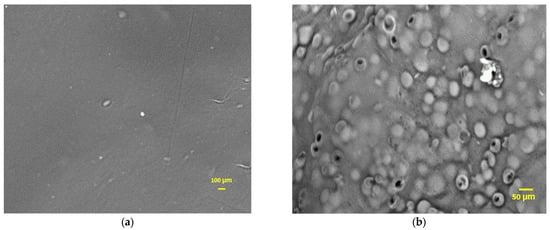
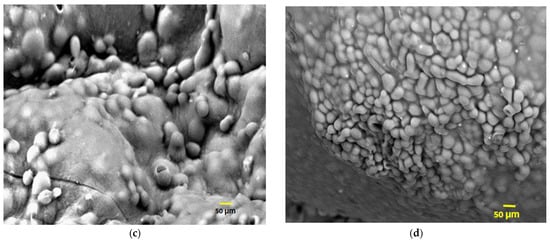
Figure 3.
SEM images on the surfaces at ×1000 magnification of (a) Ca-alginate beads without yeast; (b) Ca-alginate beads with yeast (fresh); (c) single-used Ca-alginate beads; (d) multiple-used Ca-alginate beads.
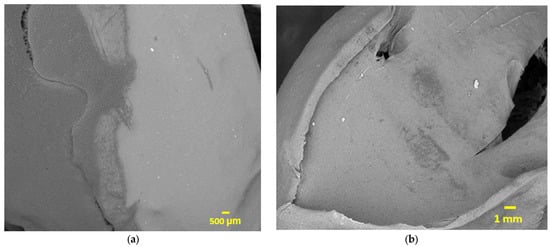
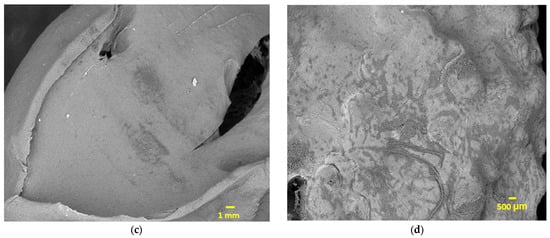
Figure 4.
SEM images of the cross sections at ×55 magnification of (a) Ca-alginate beads without yeast; (b) Ca-alginate beads with yeast (fresh); (c) single-used Ca-alginate beads; (d) multiple-used Ca-alginate beads.

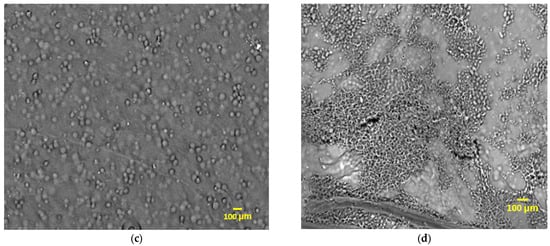
Figure 5.
SEM images on the surfaces at ×55 magnification of (a) Ca-alginate beads without yeast; (b) Ca-alginate beads with yeast (fresh); (c) single-used Ca-alginate beads; (d) multiple-used Ca-alginate beads.
4. Discussion
The immobilization of yeast in calcium alginate beads provides several significant advantages. Firstly, it is a cost-effective method as the yeast can be reused in several reaction cycles while still providing promising results. This means that the process can be scaled up without incurring additional costs associated with the purchase of new yeast. Secondly, the yeast can be easily collected and reused without the need for expensive separation techniques. Thirdly, the immobilization of yeast provides a protective layer that reduces contamination, which can be a major problem in traditional fermentation processes. Furthermore, the results of the immobilization process demonstrated reliable percent conversion and ethanol concentration throughout the fermentation period. Additionally, the immobilized beads showed remarkable reusability throughout the experiment, lasting up to 10 cycles without significant degradation in performance. The immobilized yeast also exhibited potential for use in a continuous process, which could lead to further cost savings and efficiency improvements. Another significant advantage of the immobilization process is the avoidance of yeast contamination, eliminating the need for antibiotics in the process. This is a key factor in ethanol production, as antibiotics could result in antibiotic resistance and the development of new strains of bacteria resistant to antibiotics. Overall, the immobilization of yeast in calcium alginate beads is a promising approach for ethanol production, offering a cost-effective, efficient, and environmentally friendly alternative to traditional fermentation methods.
The ethanol generated is defined as the quantity of ethanol formed in terms of the highest amount of ethanol that could be generated from the carbon source, which is sweet sorghum. It was observed that the sodium alginate concentration had a minimal effect on the performance of immobilized yeast in converting glucose to ethanol. Increasing sodium alginate concentration paved the way for greater diffusional limitation. However, this reduces the tendency of the beads to split due to their high mechanical strength, while decreasing their concentration causes leakage of the yeast due to low mechanical strength.
Free yeast had higher ethanol productivity than immobilized yeast on the first day of fermentation, as shown in Table 3. For the free yeast, a percent conversion of 60.91% was observed. On the other hand, the immobilized yeast attained a conversion of 56.36%. This was due to the decrease in the initial activity of the yeast as an effect of immobilization. The free yeast directly utilized and converted the glucose to ethanol, compared to the immobilized yeast, which first underwent several stages before the conversion of glucose to alcohol occurred. The result is different from the study conducted by Tang et al. [28], where at the first 24 h of fermentation, an almost equal amount of ethanol was produced. However, in terms of the highest ethanol productivity, both observed a similar result, which is both the immobilized yeast showed a higher percent ethanol conversion compared to the free yeast. This study obtained an 85.15% conversion of sugar to ethanol, compared to 74.55% for the free yeast. The result showed an improvement compared to the study conducted by Rakin et al. [29], which recorded a result of 57.8% w/v optimum ethanol yield.
To lessen waste and increase ethanol yield, the high conversion efficiency of the substrate is highly significant for industrial ethanol production. The immobilized yeast had a significantly higher ethanol yield compared to free yeast. The result is similar to the study on ethanol fermentation from expired rice, where immobilized yeast cells showed a higher ethanol yield compared to free yeast [30]. This was attributed to the immobilized yeast having a protective layer that diminishes the effect of the changes in pressure, pH, and temperature, as well as the product and substrate inhibition of the yeasts [31]. It was also due to the protection role of the alginate beads against osmotic and ethanol stress in the culture [28]. Therefore, on the second and succeeding days of fermentation, the immobilized yeast shows a higher percent conversion in comparison with the free yeast. The result also shows that the ethanol conversion time using immobilized yeast was longer than the free yeast. Comparable results have been observed in the study of Santos et al. [32], which displayed a longer ethanol conversion time but led to a higher ethanol yield.
From the calcium alginate bead without yeast to the multiple-used beads, there was an increase in the inoculum size of the immobilized yeast, as observed in Figure 2 and Figure 3. A large inoculum size led to a greater optimum cell density in the immobilized yeast culture. This is because of the cell growth and CO2 production that led to cell leakage and, eventually, degradation of the alginate beads [28]. Another reason for the increase in cell density is the adjustment of the immobilized yeast to the fermentation environment. Fermentation environments are similar but only differ in two factors: the amount of yeast present and the chemical composition of the raw material [33]. The increase in inoculum size was observed both in calcium alginate beads without yeast and in multiple-used beads, as shown in Figure 4 and Figure 5. However, a greater optimum cell density is visible in the immobilized yeast culture than in the one without yeast. Therefore, it can be concluded that cell immobilization on alginate beads improved yeast growth and that resulted in higher fermentative activities of the biocatalyst.
5. Conclusions
After conducting the experiment, the following conclusions were reached. The optimal sodium alginate concentration for immobilizing yeast is 3% w/v. Increasing the sodium alginate concentration can reduce the tendency of the beads to split due to a higher mechanical strength, but it poses a greater diffusional limitation. Decreasing the sodium alginate concentration can increase the tendency of the beads to split due to low mechanical strength, which can lead to yeast leakage. The optimal fermentation period for immobilized yeast is five days (120 h). While free yeast has a shorter optimum fermentation period of four days (96 h), immobilized yeast produces higher ethanol concentration and percent conversion. This is attributed to the protective layer of microorganisms, which reduces the effect of changes in pH and temperature and the product and substrate inhibition of the yeast. The immobilized yeast entrapped in calcium alginate beads can be reused for up to ten cycles of five days (120 h), resulting in a stable final ethanol concentration and percent conversion, which is higher than the optimum yield of free yeast. Therefore, it was determined that the use of calcium alginate beads enhances operational stability by reducing the loss of cell activity. SEM images of the surface and cross-sectional surface of the calcium alginate beads without yeast, calcium alginate beads with yeast, single-used beads, and multiple-used beads at 55 and 1000 magnification showed an increase in the inoculum size, which led to a high cell density in the beads.
Author Contributions
Conceptualization, R.P.A.; methodology, J.P.R.C.; software, J.P.R.C.; validation, J.P.R.C.; formal analysis, J.P.R.C., R.Y.M. and A.E.S.C.; investigation, J.P.R.C.; resources, R.P.A.; data curation, J.P.R.C.; writing—original draft preparation, J.P.R.C., R.Y.M. and A.E.S.C.; writing—review and editing, R.Y.M. and A.E.S.C.; visualization, J.P.R.C., R.Y.M. and A.E.S.C.; supervision, R.P.A.; project administration, R.P.A.; funding acquisition, R.P.A. All authors have read and agreed to the published version of the manuscript.
Funding
This research received no external funding.
Institutional Review Board Statement
Not applicable.
Informed Consent Statement
Not applicable.
Data Availability Statement
The data presented in this study are available on request from the corresponding author.
Conflicts of Interest
The authors declare no conflict of interest.
References
- Matsui, E.A.; Kryukova, E.V. Energy security is an important component of national security. SHS Web Conf. 2021, 110, 01049. [Google Scholar] [CrossRef]
- Choi, A.E.S.; Roces, S.A.; Dugos, N.P.; Wan, M.-W.W. Parametric Screening Analysis for the Oxidative Desulfurization of Diesel Oil. Chem. Eng. Trans. 2021, 88, 91–96. [Google Scholar] [CrossRef]
- Mohd Azhar, S.H.; Abdulla, R.; Jambo, S.A.; Marbawi, H.; Gansau, J.A.; Mohd Faik, A.A.; Rodrigues, K.F. Yeasts in sustainable bioethanol production: A review. Biochem. Biophys. Rep. 2017, 10, 52–61. [Google Scholar] [CrossRef] [PubMed]
- Choi, A.E.S.; Roces, S.A.; Dugos, N.P.; Wan, M.W. Ultrasound assisted oxidative desulfurization: A comprehensive optimization analysis using untreated diesel oil. Comput. Chem. Eng. 2022, 166, 107965. [Google Scholar] [CrossRef]
- Mamuad, R.Y.; Racuya, J.H.; Earvin, A.; Choi, S. Charcoal Briquette Production from Peanut (Arachis hypogaea L.) Shells using Cornick Industry Wastewater as Binder through a Torrefaction Process. Chem. Eng. Trans. 2022, 94, 1183–1188. [Google Scholar] [CrossRef]
- Mamuad, R.Y.; Pascual, M.F.T.; Choi, A.E.S. Development of a low-cost dispenser-type water filtration system. Clean. Responsible Consum. 2022, 7, 100085. [Google Scholar] [CrossRef]
- Mamuad, R.Y.; Caparanga, A.R.; Choi, A.E.S.; Lu, M.C. Remediation of oxalate in a homogeneous granulation process in the frame of crystallization. Chem. Eng. Commun. 2022, 209, 378–389. [Google Scholar] [CrossRef]
- Owusu, P.A.; Asumadu-Sarkodie, S. A review of renewable energy sources, sustainability issues and climate change mitigation. Cogent Eng. 2016, 3, 1167990. [Google Scholar] [CrossRef]
- Bušić, A.; Marđetko, N.; Kundas, S.; Morzak, G.; Belskaya, H.; Ivančić Šantek, M.; Komes, D.; Novak, S.; Šantek, B. Bioethanol Production from Renewable Raw Materials and Its Separation and Purification: A Review. Food Technol. Biotechnol. 2018, 56, 289–311. [Google Scholar] [CrossRef]
- Xiao, M.Z.; Sun, Q.; Hong, S.; Chen, W.J.; Pang, B.; Du, Z.Y.; Yang, W.B.; Sun, Z.; Yuan, T.Q. Sweet sorghum for phytoremediation and bioethanol production. J. Leather Sci. Eng. 2021, 3, 32. [Google Scholar] [CrossRef]
- Ariyajaroenwong, P.; Laopaiboon, P.; Laopaiboon, L. Improvement of batch and continuous ethanol fermentations from sweet sorghum stem juice in a packed bed bioreactor by immobilized yeast cells under microaeration. Bioresour. Technol. Rep. 2022, 17, 100908. [Google Scholar] [CrossRef]
- Alibuyog, C.; Demafelis, R.B.; Movillon, L.O.; Marco, R.; Calibo, S. Sweet sorghum: Food, feed, fodder and fuel crop. In Proceedings of the 1st Sweet Sorghum Summit and Plantation Showcase: Unmasking the Potential of Sweet Sorghum for a Competitive Business Enterprise, Bacolod, Plilippines, 1–3 June 2011; p. 19. [Google Scholar]
- Mathur, S.; Umakanth, A.V.; Tonapi, V.A.; Sharma, R.; Sharma, M.K. Sweet sorghum as biofuel feedstock: Recent advances and available resources. Biotechnol. Biofuels 2017, 10, 146. [Google Scholar] [CrossRef]
- Karagoz, P.; Bill, R.M.; Ozkan, M. Lignocellulosic ethanol production: Evaluation of new approaches, cell immobilization and reactor configurations. Renew. Energy 2019, 143, 741–752. [Google Scholar] [CrossRef]
- Tse, T.J.; Wiens, D.J.; Reaney, M.J.T. Production of Bioethanol—A Review of Factors Affecting Ethanol Yield. Fermentation 2021, 7, 268. [Google Scholar] [CrossRef]
- Singh, A.; Bishnoi, N.R. Optimization of ethanol production from microwave alkali pretreated rice straw using statistical experimental designs by Saccharomyces cerevisiae. Ind. Crops Prod. 2012, 37, 334–341. [Google Scholar] [CrossRef]
- Da Silva Fernandes, F.; De Souza, É.S.; Carneiro, L.M.; Alves Silva, J.P.; De Souza, J.V.B.; Da Silva Batista, J. Current Ethanol Production Requirements for the Yeast Saccharomyces cerevisiae. Int. J. Microbiol. 2022, 2022, 7878830. [Google Scholar] [CrossRef]
- Hermansyah, H.; Panagan, A.T.; Fatma, F.; Susilawati, S. Indigenous Yeast for Bioethanol Production. J. Phys. Conf. Ser. 2021, 1940, 012044. [Google Scholar] [CrossRef]
- Barik, J. Effect of immobilization on production of ethanol using yeast cells. Dep. Life Sci. Natl. Inst. Technol. 2014, 23. Available online: http://ethesis.nitrkl.ac.in/6233/1/412LS2033-14.pdf (accessed on 19 February 2023).
- Ivanova, V.; Petrova, P.; Hristov, J. Application in the Ethanol Fermentation of Immobilized Yeast Cells in Matrix of Alginate/Magnetic Nanoparticles, on Chitosan-Magnetite Microparticles and Cellulose-coated Magnetic Nanoparticles. Chem. Phys. 2011, 3, 289–299. [Google Scholar]
- Abdulla, R.; Ajak, W.A.; Hajar, S.; Derman, E. Stability Studies of Immobilized Saccharomyces cerevisiae in Calcium Alginate and Carrageenan Beads. Int. J. Health Med. 2017, 2. [Google Scholar] [CrossRef]
- Wang, J.; Chae, M.; Sauvageau, D.; Bressler, D.C. Improving ethanol productivity through self-cycling fermentation of yeast: A proof of concept. Biotechnol. Biofuels 2017, 10, 193. [Google Scholar] [CrossRef] [PubMed]
- Ndubuisi, I.A.; Qin, Q.; Liao, G.; Wang, B.; Moneke, A.N.; Ogbonna, J.C.; Jin, C.; Fang, W. Effects of various inhibitory substances and immobilization on ethanol production efficiency of a thermotolerant Pichia kudriavzevii. Biotechnol. Biofuels 2020, 13, 91. [Google Scholar] [CrossRef] [PubMed]
- Calinescu, I.; Corina, T.; Petre, C.; Adrian, T.; Elvira, A.; Ionescu, A.; Dima, R. Saccharomyces cerevisiae immobilization in polyacrylamide hydrogel obtained at low temperature. Rom. Biotechnol. Lett. 2012, 17, 7628–7638. [Google Scholar]
- Bickerstaff, G.F. Immobilization of Enzymes and Cells; Humana Press: Totowa, NJ, USA, 1997. [Google Scholar]
- Guisan, J.M. Immobilization of Enzymes and Cells IN Series Editor; Springer: Berlin/Heidelberg, Germany, 2013; Volume 1051, ISBN 9781627035491. [Google Scholar]
- Duarte, J.C.; Rodrigues, J.A.R.; Moran, P.J.S.; Valença, G.P.; Nunhez, J.R. Effect of immobilized cells in calcium alginate beads in alcoholic fermentation. AMB Express 2013, 3, 31. [Google Scholar] [CrossRef] [PubMed]
- Tang, P.D.P.; Le, V.V.M. Fermentation performance of free and immobilized yeast on cork (Sonneratia caseolaris) root—Application of immobilized yeast to repeated batch ethanol fermentation. Int. Food Res. J. 2013, 20, 1813–1817. [Google Scholar]
- Rakin, M.; Mojovic, L.; Nikolic, S.; Vukasinovic, M.; Nedovic, V. Bioethanol production by immobilized Sacharomyces cerevisiae var. ellipsoideus cells. Afr. J. Biotechnol. 2009, 8, 464–471. [Google Scholar]
- Liu, Q.; Zhao, N.; Zou, Y.; Ying, H.; Chen, Y. Feasibility of ethanol production from expired rice by surface immobilization technology in a new type of packed bed pilot reactor. Renew. Energy 2020, 149, 321–328. [Google Scholar] [CrossRef]
- Galanakis, C.M.; Kordulis, C.; Kanellaki, M.; Koutinas, A.A.; Bekatorou, A.; Lycourghiotis, A. Effect of pressure and temperature on alcoholic fermentation by Saccharomyces cerevisiae immobilized on γ-alumina pellets. Bioresour. Technol. 2012, 114, 492–498. [Google Scholar] [CrossRef]
- Santos, E.L.I.; Rostro-Alanís, M.; Parra-Saldívar, R.; Alvarez, A.J. A novel method for bioethanol production using immobilized yeast cells in calcium-alginate films and hybrid composite pervaporation membrane. Bioresour. Technol. 2018, 247, 165–173. [Google Scholar] [CrossRef]
- Maykish, A.; Rex, R.; Sikalidis, A.K. Organic Winemaking and Its Subsets; Biodynamic, Natural, and Clean Wine in California. Foods 2021, 10, 127. [Google Scholar] [CrossRef]
Disclaimer/Publisher’s Note: The statements, opinions and data contained in all publications are solely those of the individual author(s) and contributor(s) and not of MDPI and/or the editor(s). MDPI and/or the editor(s) disclaim responsibility for any injury to people or property resulting from any ideas, methods, instructions or products referred to in the content. |
© 2023 by the authors. Licensee MDPI, Basel, Switzerland. This article is an open access article distributed under the terms and conditions of the Creative Commons Attribution (CC BY) license (https://creativecommons.org/licenses/by/4.0/).